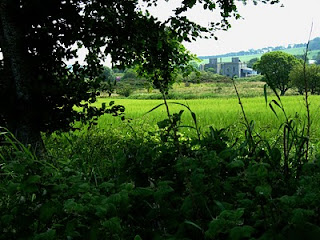This marker is alongside the track (right going towards Maud) just before the bridge near Viewbank. We presume it indicates the distance, in miles, to Aberdeen, the circles representing quarter miles. We have so far been unable to locate further signs.
'The Railways Clauses Consolidation Act 1845 required that the railway companies provide markers at quarter mile intervals along the track side. Section 94 of the Act read:
"The company shall cause the length of the railway to be measured, and milestones, posts, or other conspicuous objects to be set up and maintained along the whole line thereof, at the distance of one quarter of a mile from each other, with numbers or marks inscribed thereon denoting such distances."
One reason for compelling the railway companies to have mileposts installed was that it allowed passengers to verify that they had been charged an appropriate fare for the length of their journey.' http://www.railsigns.co.uk/
Also on the right along this section of line is this hut constructed, apart from the roof and chimney, entirely of sleepers. This attractive cast iron bridge parapet carries the line over the road to Strichen Mains.
Just before the bridge there are good views (to the left) of the ruins of Strichen House and the unfortunate corrugated iron agricultural extension.
Botanically this is a rewarding section. Close to Strichen wild strawberries, (Fragaria vesca) (pictured below) and wood avens line the track. there are beautiful bushes of white and pink dog roses, broom and gorse.
In the same area there is also an abundance of Sweet Cicely (myrrhis odorata). For Grey Granite this plant always evokes Flora Garry's eponymous poem, a great favourite of her friend Eva who spent her childhood in Strichen during the 1920's
' We ca'ad it myrrh. It cam at the bare time
O langblae licht an broon new shaaven ley,
Skwylin teuchart, reek o burnin grouth,
The caal Gab o Mey'
By the first cutting this vegetation is replaced by predominantly rosebay willow herb, nettles, ferns and brambles. There is an ivy covered road bridge over the line near ViewBank.
Trees along this section include the occasional Scots pine, beech, ash, mountain ash, sycamore, silver birch, willows and two or three hazels.
Grey Granite was plesaed to see a ringlet butterfly during her walk today.















